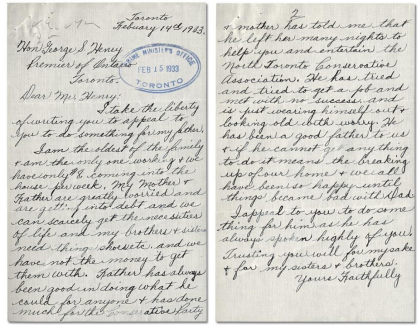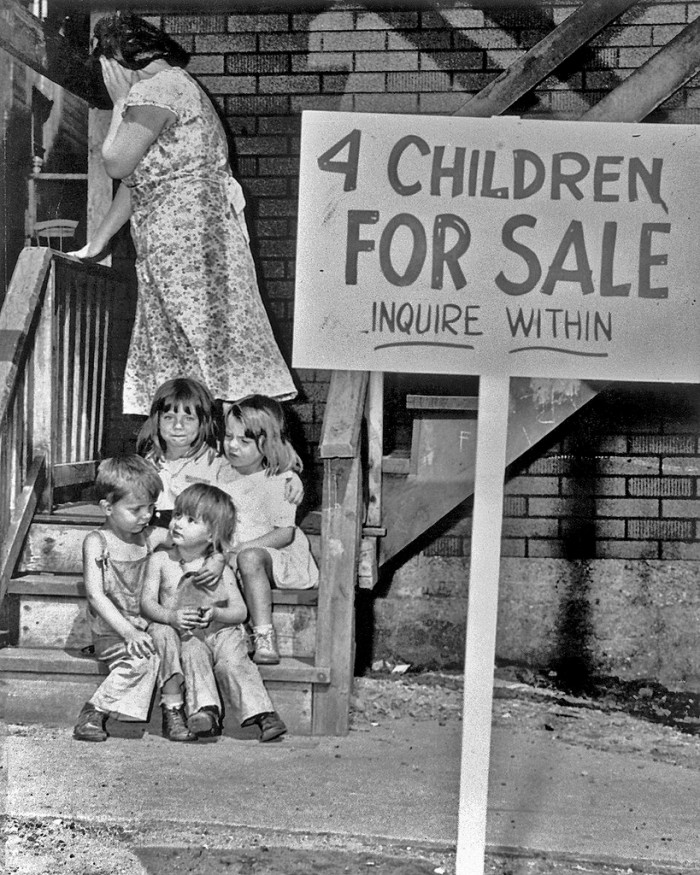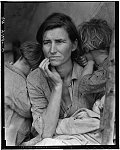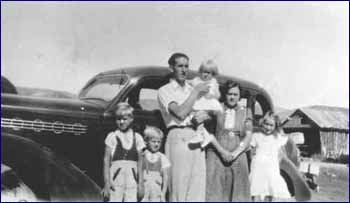My research paper topic deals with the use a child narrator in “Walker Brothers Cowboy” by Alice Munro. Throughout her short story, the work is told by the young daughter, and everything is told from her point of view (including scenes with her mother who seems to be in denial about their financial situation and scenes with her father at his new job after losing his last one. ) Additionally, it is important to note that this story took place in the 1930’s around the Great Depression, and that is what I focused on for my timeline.
Archives of Ontario: Letter: Toronto, Ontario February 1933

February 1933 http://www.oldmagazinearticles.com/article-summary/women-during-the-1930s-great-depression#.WEGJtKIrLow
This is a letter written to George Henry a correspondent, and written by an older boy in a family in need. In the letter he explains how he is the only one working to support his entire family, and then explains the hardships his father has suffered despite always doing what he can to provide.
Return of the Lady- Newspaper article by Claire Howe

1934 http://www.oldmagazinearticles.com/article-summary/women-during-the-1930s-great-depression#.WEGJtKIrLow
This newspaper article was published in 1934 and addressed how and what women were doing (or being forced to do) during the time of the Great Depression. The article tells of how the great depression forced women to stop fighting for their rights and slowed all types of progression, especially due to the fact the government was trying to force women to chose between a marriage license and having a job.
Dear Mr. Roosevelt letter
March 25, 1935 http://newdeal.feri.org/eleanor/cvb0335.htm
During the Great Depression, many children took to writing letters to President Roosevelt’s wife, and asked for things like money, clothes, or any help at all really. This specific letter was written by an 11-year-old girl who was asking if Mrs. Roosevelt had any old clothes to hand down to them for Easter.
Dorthea Lange’s “Migrant Mother” photograph of Florence Thompson

February 1936 http://www.todayifoundout.com/index.php/2014/08/woman-famous-great-depression-photograph/
Dorthea Lange, a photographer best known for her photo’s during the great depression, took this shot of Florence Thompson, a mother of five children at the time who was struggling to find work and money. This photo was referred to as the symbol of the Great Depression.
Kellogg’s PEP Cereal Advertisement

1938 http://www.historybyzim.com/2013/07/odd-ads-of-the-past-pep-vitamins/
This advertisement was just one of many that tried to show why women needed to stay home during the depression and let men get the jobs. This is just a cereal advertisement, but it showed just how desperate the workforce was at the time, and the limited job availability.
Life During the Great Depression interview with Jay Spencer

December 7, 1997 http://newdeal.feri.org/sevier/interviews/413s.htm
This is a written interview from a man who had to raise his family during the great depression. Jay spencer, the man pictured above, recounts his time in this interview before, during, and after the depression and what he had to do to help his family.
Survivors Of The Great Depression Tell Their Stories by Neenah Ellis (Audio Clip)
http://www.npr.org/templates/story/story.php?storyId=97468008
November 2008
Three great depression survivors recount their experiences as children going through that time period. Each of them talk about their parent’s struggles to find to jobs and how that affected the families.
Between ‘what we know and what we do not yet know’Alice Munro’s ‘Walker Brothers Cowboy’ Scholarship by Aloka Patel
May 2014
This scholarship responding to Walker Brothers Cowboy present’s the argument of role reversal between the father and daughter (the narrator) due to the setting of the time which was the Great Depression. Patel argues that it is the narrator who is maturing and growing throughout, where as the father has more childlike behavior to situations concerning the emotional structure of the family, as well as their financial problems.
Works Cited
Patel, Aloka. “Between ‘what we Know and what we do Not Yet Know’1 Alice Munro’s ‘Walker Brothers Cowboy’.” Transnational Literature 6.2 (2014): 1-12. ProQuest. Web. 2 Dec. 2016.




